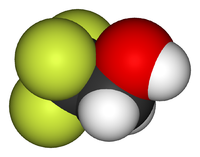- 2,2,2-trifluoroéthanol
-
2,2,2-trifluoroéthanol 

Général Nom IUPAC 2,2,2-trifluoroéthanol Synonymes fluorinol 85 No CAS No EINECS No RTECS PubChem ChEBI SMILES InChI Apparence liquide incolore Propriétés chimiques Formule brute C2H3F3O [Isomères] Masse molaire[2] 100,0398 ± 0,0021 g·mol-1
C 24,01 %, H 3,02 %, F 56,97 %, O 15,99 %,pKa 12,37 à 25 °C[1] Propriétés physiques T° fusion -44 °C[3]
-43,5 °C[4],[1]T° ébullition 77–80 °C[3]
75 ± 3 °C[4]
74 °C[1]Solubilité miscible dans l'eau et l'éthanol Masse volumique 1,373 g·cm-3 à 25 °C[3] T° d'auto-inflammation ~480 °C[3] Point d’éclair 29 °C[3] Pression de vapeur saturante 70 mmHg à 25 °C[3]
71,3 mmHg à 25 °C[1]Propriétés optiques Indice de réfraction  = 1,3[3]
= 1,3[3]Précautions Directive 67/548/EEC[3] 
XnPhrases R : 10, 20/21/22, 37/38, 41, Phrases S : 26, 36, 39, Transport - 1986 NFPA 704 Écotoxicologie DL50 1 680 mg·kg-1 (rat, s.c.)[1]
0,39 ml·kg-1 (lapin, s.c.)[1]
366 mg·kg-1 (souris, oral)[1]
240 mg·kg-1 (rat, oral)[1]
250 mg·kg-1 (souris, i.v.)[1]
158 mg·kg-1 (souris, i.p.)[1]
210 mg·kg-1 (rat, i.p.)[1]CL50 2900 mg/m3/2H (souris, inhalation)[1]
470 ppm/6H (rat, inhalation)[1]Unités du SI & CNTP, sauf indication contraire. Le 2,2,2-trifluoroéthanol est un composé organique halogéné, portant une fonction alcool et de formule semi-développée CF3CH2OH. Aussi connu sous les noms TFE ou alcool trifluoroéthylique, ce liquide incolore miscible avec l'eau a un odeur rappelant celle de l'éthanol. En raison de l'électronégativité du groupe trifluorométhyle, cet alcool a un caractère acide plus marqué que l'éthanol. Ainsi, le TFE forme des complexes stables aussi avec des hétérocycles comme le THF ou la pyridine, en établissant des liaisons hydrogène.
Sommaire
Production et synthèse
Le trifluoroéthanol est produit industriellement par hydrogénation ou par réduction grâce à un hydrure, de dérivés de l'acide trifluoroacétique comme des esters ou son chlorure d'acyle[5].
Il peut être aussi préparé par hydrogénolyse de composés diol ou hémicétal de formule générale CF3−CHOH−OR (où R est un atome d'hydrogène (diol) ou un groupe alkyle contenant de un à huit atomes de carbone (hémicétal)) en présence d'un catalyseur au palladium déposé sur charbon activé et, en tant que co-catalyseur, d'amines tertiaires aliphatiques comme la triéthylamine.
Utilisation
Le trifluoroéthanol est utilisé comme solvant en chimie organique[6],[7]. L'oxydation de composé sulfurés avec le peroxyde d'hydrogène est effectivement conduite dans le TFE[8]. Il sert également de source du groupe trifluoroéthyle dans diverses réactions chimiques[9].
En biologie, le trifluoroéthanol est utilisé comme co-solvant dans les études du repliement des protéines par spectroscopie RMN : il peut effectivement solubiliser peptides et protéines. En fonction de sa concentration, le trifluoroéthanol peut fortement affecter la structure tridimensionnelle des protéines.
Le 2,2,2-trifluoro-1-vinyloxyéthane, un médicament qui s'inhale, présenté cliniquement sous le nom commercial Fluromar®, est l'éther vinylique du trifluoréthanol. Cette molécule est préparée par la réaction de trifluoroéthanol avec l'acétylène[5].
Dans l'industrie, le trifluoroéthanol est employé comme solvant du nylon ainsi que dans des applications du domaine pharmaceutique.
Réaction
L'oxydation du trifluoroéthanol produit du trifluoroacétaldéhyde et de l'acide trifluoroacétique.
Notes et références
- (en) Cet article est partiellement ou en totalité issu de l’article de Wikipédia en anglais intitulé « 2,2,2-Trifluoroethanol » (voir la liste des auteurs)
- Trifluoroethanol sur ChemIDPlus
- Masse molaire calculée d’après Atomic weights of the elements 2007 sur www.chem.qmul.ac.uk.
- 2,2,2-Trifluoroethanol chez Sigma-Aldrich.
- NIST : Ethanol, 2,2,2-trifluoro-.
- Günter Siegemund, Werner Schwertfeger, Andrew Feiring, Bruce Smart, Fred Behr, Herward Vogel, Blaine McKusick “Fluorine Compounds, Organic”, Ullmann's Encyclopedia of Industrial Chemistry, John Wiley & Sons, 2007.
- Bégué, J.-P.; Bonnet-Delpon, D.; Crousse, B., « Fluorinated Alcohols: A New Medium for Selective and Clean Reaction », dans Synlett, no 1, 2004, p. 18–29 [lien DOI]
- Shuklov, Ivan A. ; Dubrovina, Natalia V.; Börner, Armin, « Fluorinated Alcohols as Solvents, Cosolvents and Additives in Homogeneous Catalysis », dans Synthesis, vol. 2007, 2007, p. 2925–2943 [lien DOI]
- Kabayadi S. Ravikumar, Venkitasamy Kesavan, Benoit Crousse, Danièle Bonnet-Delpon, and Jean-Pierre Bégué (2003). "Mild and Selective Oxidation of Sulfur Compounds in Trifluorethanol: Diphenyl Disulfide and Methyle Phenyl Sulfoxide". Org. Synth. 80: 184.
- par exemple dans la modification de Still-Gennari de la réaction de Horner–Wadsworth–Emmons (en)
- (en) Halocarbon Fluorochemicals
- (en) United States Patent number 4,647,706 : Process for the synthesis of 2,2,2-Trifluoroethanol and 1,1,1,3,3,3-Hexafluoroisopropanol.
Catégories :- Produit chimique nocif
- Composé trifluorométhylé
- Alcool (chimie)
Wikimedia Foundation. 2010.


